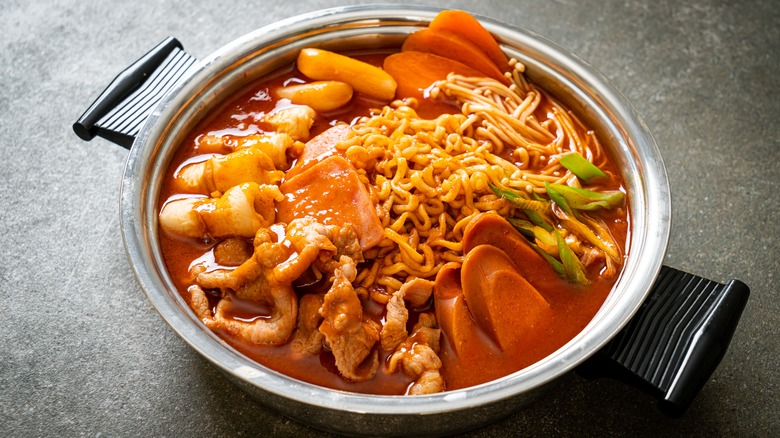Budae Jjigae: The Korean Army Base Stew That Became A Comfort Food
Budae jjigae is where the East meets the West in an unusual concoction that has become a popular symbol of where South Korea has been and where it is going. Originating during the Korean War, the strew is made from what may feel like a lot of odds and ends tossed together, such as Spam, hot dogs, tofu, kimchi, green onion, and instant ramen noodles, according to Crazy Korean Cooking. The resulting flavor is complex and spicy. The name translates to "army base stew" with "budae" meaning "army base" and "jjigae" meaning "stew," cites Korean Bapsang.
Over the decades, budae jjigae has been classified as comfort food, per Atlas Obscura, and is served at restaurants and in home kitchens in South Korea. Army base stew has been updated by some cooks with more traditional ingredients, such as rice cakes (ddeok), kimchi, and gochujang, per Crazy Korean Cooking. But, at its core, budae jjigae's history is that of survival and making do with very little.
The history of budae jjigae
Before trying budae jjigae, it's important to first understand its origin. During the Korean War, there was a lack of food, especially meat, in the country so Koreans would get what they could from the U.S. military bases, even leftovers that would have otherwise ended up in the trash, according to Atlas Obscura. After the war ended in 1953, Koreans still lacked access to a lot of food, such as meat, after three years of fighting. They would often turn to the black market to get the American foods they had learned to like in the budae jjigae after the Korean government made it difficult to get the items due to passing import laws. After some time, the ban on American-made goods was lifted and the dish still remained popular, according to Atlas Obscura.
An important part of budae jjigae, Spam, wasn't legal in South Korea until a company there began to produce it in the 1980s. An area near the U.S. military base in Uijeongbu, an hour north of Seoul, is one of the best places to get budae jjigae, per My Korean Kitchen. While the dish may have originated near U.S. military bases, its popularity has spread further.
What ingredients are in budae jjigae?
As to be expected based on budae jjigae's processed ingredients like Spam and hot dogs, the stew is salty, but Maangchi says it's also savory and spicy.
There are many recipes with different variations for budae jjigae; after all, it's always been made with what was available. Maangchi's recipe calls for a stock made of mushrooms, anchovies, kelp, water, and salt. She also uses a seasoning paste to make the stew, which is comprised of pork belly, sweet potato starch noodles, cabbage, onions, kimchi, sausage, Spam, ramen, tofu, sprouts, baked beans, and American cheese. Of the different available recipes, kimchi, hot dogs, Spam, ramen noodles, tofu, and rice cakes are almost always incorporated into the dish. Crazy Korean Cooking uses Spam and hot dogs and adds beef bone broth, ground pork, and processed cheese to the stew. For its base, Korean Bapsang uses anchovy broth and adds a variety of ingredients, including bacon and red bell peppers.
How to make budae jjigae
Despite budae jjigae containing more than a dozen ingredients, My Korean Kitchen says making it is pretty easy. Most of the work to make the army base stew is preparing the ingredients by cutting and slicing them. Also, My Korean Kitchen says it can easily be adapted to taste preferences and what is on hand. To make the stew, they say you only need one pot in which to cook it.
According to Crazy Korean Cooking, with several of the budae jjigae items being pre-seasoned (hot dogs, Spam, etc.), the amount you use will determine how salty the finished stew is. The noodles and rice cakes used can also help offset some of the salt and spiciness, but Crazy Korean Cooking cautions that if too much is used then the stew will become too thick. A recipe on Food Network describes budae jjigae as a great item to make while camping because many of the ingredients are easy to transport in a cooler and the broth and toppings can be made ahead of time.
How to enjoy budae jjigae
When making army base stew, My Korean Kitchen likes to use a 12-inch shallow pot that can be placed on a portable burner with the diners gathered around it. As a result, the diners can have a more communal experience of eating the budae jjigae, almost like a Korean hot pot. Korean Bapsang agrees with this style of eating the stew and recommends adding more ingredients to the pot as the diners remove them to be eaten. Adding ingredients works because most of the budae jjigae's ingredients cook quickly.
Individual bowls can be provided for the diners if the budae jjigae is eaten communally, advises Crazy Korean Cooking. Also, turn down the flame on the portable burner so that it simmers as people dig in with their chopsticks. Feel free to add more broth as the stew boils down. Budae jjigae is often enjoyed with steamed white rice. Food Network says in the final minute of cooking, the cheese should be placed over the ramen and then the whole pot can be removed from the heat. To finish the dish, scallions or chiles can be sprinkled on top.




